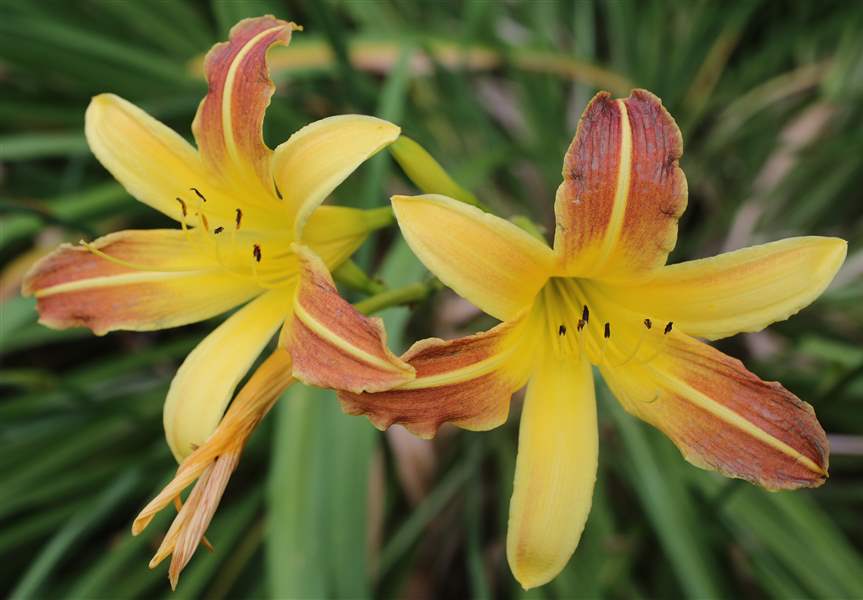
Daylilies in peak bloom
7/10/2018
A daylily pictured in Holland, Ohio.
THE BLADE/JEREMY WADSWORTH
Buy This Image
Let’s begin with a gardener’s quiz. Last week’s column included a quick lesson on Latin for gardeners. If you see the word Hemerocallis — note that the word is CAPITALIZED and in italics — what plant do you think we are talking about?

Amy Stone
Need a hint? Let’s breakdown the word Hemerocallis into two parts: Hemera means day; and kalos means beautiful. What perennial plant has the name “day” in its name?
I can just imagine shouts from behind the newspaper, at your computer, or on your tablet or cell phone — DAYLILY! Great job gardeners!
Hemerocallis is the genus, the first part of the Latin binomial, for daylily. There are numerous species and thousands of cultivars. This perennial plant returns every year, often in abundance, and can easily be divided and transplanted in your garden or shared with family and friends.
With a name like daylily you may wonder how long does the plant provide joy in your garden. While the individual blooms typically last a day, the plant will provide weeks of color as new blooms come on the scene and open up one after another. The grass-like foliage can also be attractive in clumps by themselves, in mass, or planted in swaths in a mixed perennial garden. The size and color of blooms vary greatly by species. Gardeners can quickly become collectors of these easy to care for perennials.
As much as gardeners love daylilies, the deer do too. The four-legged creatures love to nibble on foliage in the very early spring and most recently the flower buds. Know that if you have deer, their daylily-liking can lead to your disappointment when the plant is bloomless.
Daylilies are native to Asia, including China, Korea, and Japan. The plant is popular because of its hardiness and showy combination of colors. Some flowers are very fragrant, while others are not. They are often referred to as early season, midseason, and late season bloomers. Choosing plants in each of the groups can further extend the bloom season and splash of color in your garden.
Hopefully at this point in the column, I have grabbed your attention and piqued your interest. Whether you already have a daylily or two in your landscape, have gotten bitten by the daylily-bug and are starting to collect, or you have already lost track of the number of cultivars that you have, there is nothing like seeing these plants displayed in a garden. It is there you can get a true sense of size, color, and scent. You can also compare cultivars that might have similar descriptions in catalogs or on the web and choose your favorite.
In the Toledo area you don’t have to go far to see such a display. “The Daylily Walk at Toledo Botanical Garden features more than 400 cultivars. The daylilies on display have received special awards given annually by the American Hemerocallis Society, including two rare discontinued awards,” said Jonathan Milbrodt, the garden’s lead horticulturist with Metroparks Toledo.
“The daylily collection at Toledo Botanical Garden began in the early 1990s and since 1998 the collection has grown significantly through a partnership with the Black Swamp Hosta and Daylily Society, which donates materials, new acquisitions, and helps the Metroparks maintain the collection through their volunteer efforts. In 2014, the daylily beds were expanded to double the collection size and allow space for future additions,” Mr. Milbrodt said. In others words, the collection will keep growing.
The daylily collection is in Toledo Botanical Garden’s Perennial Garden along the southeast perimeter and is in peak bloom this week, so plan your trip quickly. While enjoying the beautiful blooms, you will notice that the plants are grouped by award categories and arranged in chronological order of the award year within each category. The plant labels include the cultivar name and credits the plants’ hybridizer too.
Don’t let the day go by without seeing the daylilies.
Amy Stone is an extension educator with the Ohio State Extension–Lucas County, Agriculture and Natural Resources. Contact her at: stone.91@osu.edu